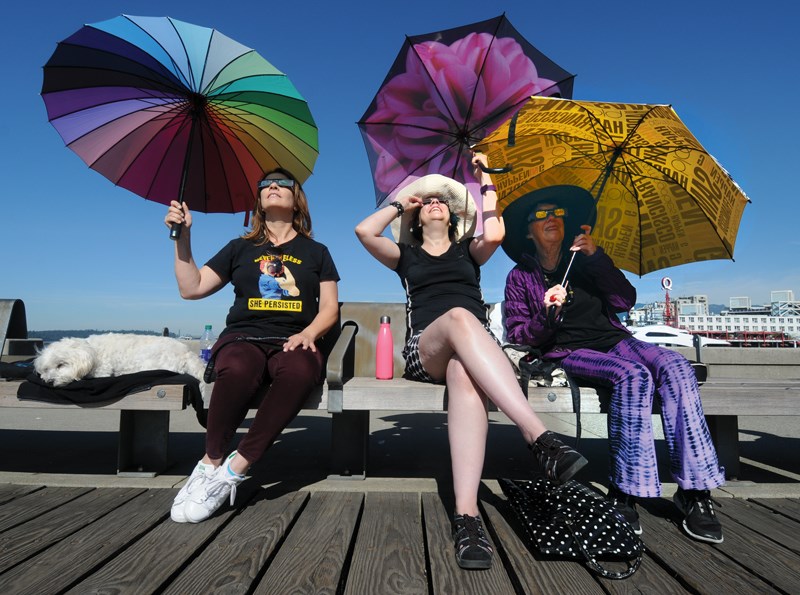There’s a sun and there’s a moon and rarely the twain shall meet.
But that was the case Monday morning when North Vancouver was in the path of an approximately 86 per cent solar eclipse.
About 100 people gathered on the Burrard Dry Dock Pier to watch, some using disposable eclipse viewing glasses to protect their eyes from the dangerous ultraviolet light, others using pinhole viewers that gave them a safe, indirect view of the sun cast on to the inside of a cereal or shoe box.
The Earth’s orbit around the sun is offset by about five degrees from the moon’s orbit around Earth, putting the three heavenly bodies on course to come into alignment on rare but predictable occasions. The last time a total eclipse was viewable in this part of the world was on Feb. 26, 1979.
“We are so ready for this, man,” said Karen Firus, who was joined by her mother Molly and friend Tammy Wood, the three of them equipped with viewing glasses, parasols and sun hats.
Wood flew in from Los Angeles after earlier plans to go directly to the “path of totality” in Oregon fell through.
“This is historical stuff, baby,” Firus added.
As the moon gradually obscured the sun, the light cast on the ground and water acquired a filtered look, muting the otherwise vibrant colours of things around.
The temperature dropped as well, only by about 1.2 degrees Celsius, according to Environment Canada, but folks began covering their goosebumped skin with jackets and blankets.
As the moon transited in front of the sun, it followed a slightly downward trajectory leaving a crescent-shaped sliver at the top.
“Is it getting redder or is that just my retina burning?” Firus joked, staring up at the sky.
Around 10:20 a.m., the sun was as obscured as it’s going to get for another 754 years, at least in this part of the world. Wood applauded.
“It’s beautiful, it’s beautiful,” she called out.
Solar eclipses are known to provoke strange behaviour in animals, though the dogs who made the trip to the pier with their humans evidently cared little for the event of astronomical proportions, showing more interest in sniffing and barking at each other.
Stanley Greenspoon, professor emeritus at Capilano University and volunteer for the Royal Astronomical Society of Canada, made the trip down to Stayton, Ore., a town very near the centre line of the path of totality.
The town had a festival-like atmosphere with music and refreshments and children playing while the moon slowly bit away from the sun’s disk. But the event took on a different, quieter tone, when the total phase of the eclipse began.
“When I could no longer see any of the sun’s disk, I removed my eclipse glasses and viewed the sun completely obscured by the dark disk of the moon with the sun’s wispy outer atmosphere, the corona, extending at least one sun’s diameter around the sun,” Greenspoon wrote in an email.
“We could hear scattered applause and gasps from our fellow observers at this beautiful sight. It was sufficiently dark for the streetlights to automatically turn on. The two minutes of totality seemed to go by very quickly after which we put our eclipse glasses back on to safely view the sun star returning to its normal appearance. … The diamond ring effect, observed just after the total phase of the eclipse ended was spectacular.”
Traffic was extremely heavy on the drive north to Seattle but “it was all worth it for this probably once-in-a-lifetime experience,” Greenspoon added.



